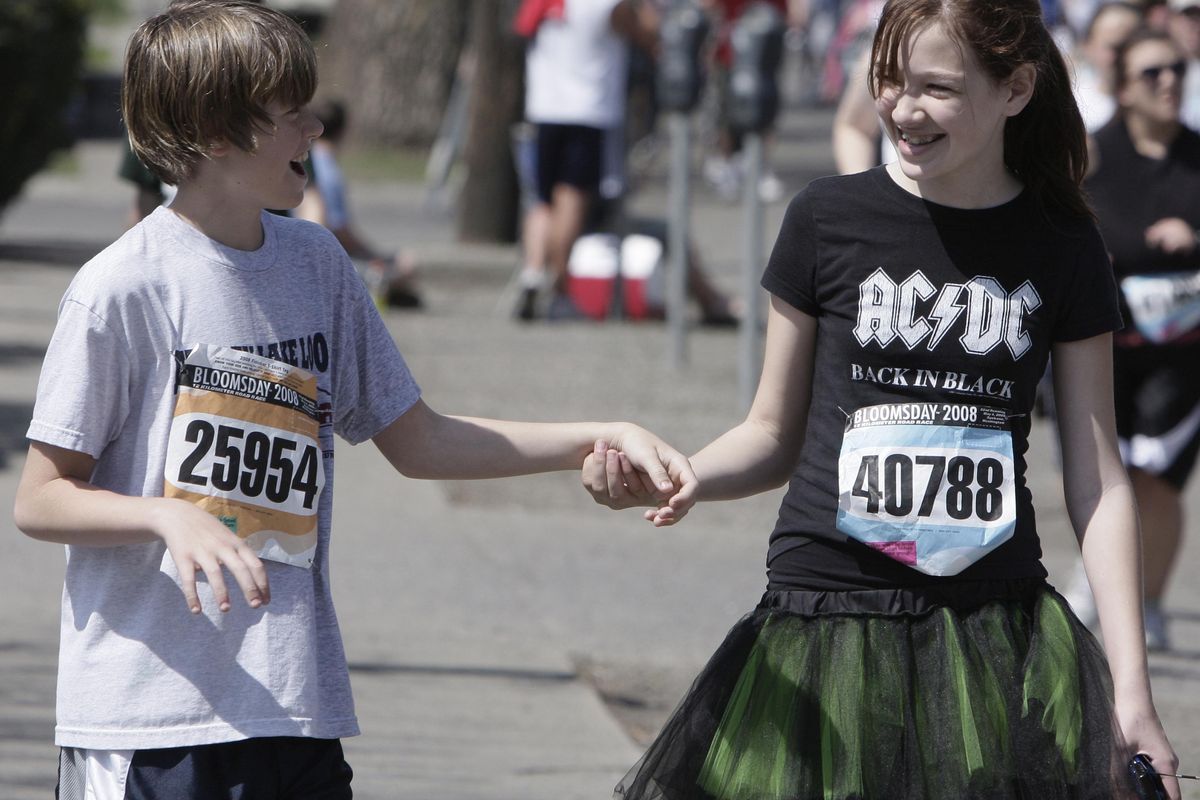Bloomsday through the ages: While much of the field is middle-aged, race draws a good number of youngsters

Beyond its 40 years, Bloomsday seems almost ageless.
From youngsters in strollers to grandparents strolling hand-in-hand, a multigenerational crowd of people run, walk or glide each year to cover the 7 1/2-mile course in downtown Spokane. Just over 43,000 runners and walkers finished in 2016.
Since at least 1988, the Lilac Bloomsday Association has compiled data on finishers’ ages within different group brackets – broken up into segments between zero and 70-plus – but an average age for the race is 39.
“Our biggest age groups are sort of in the middle, there somewhere around 30 to 40, but we get participation kind of all the way through,” said Don Kardong, race founder and director. This year’s Bloomsday is May 7.
“I think we have between 20 and 25 percent who are 18 and younger. Once we get up to the 50s or 60s age-range, participation is not quite as strong.”
Another well-represented age group last year was the one for females ages 19-29, totaling just over 5,000.
Each year, though, even the tiniest ones get counted, with 5,072 children in the 0-12 age category for 2016. Bloomsday’s eldest winners last year were three men, two of them at age 92 and one crossing the finish at 91. The eldest female age-group had one woman who covered the course at age 89.
Nearly 30 years ago, the 70-plus range drew 215 people. The over-70 crowd by 2016 grew to just over 1,200, perhaps with the perks of modern joint surgeries and people remaining more active while aging.
As decades go by, people are more likely to participate by walking than running, Kardong said.
And then there are Bloomsday Perennials – those men and women who have finished every race since it began in 1977.
All 92 Perennials finished their 40th race nearly a year ago, and several of them are in their 60s, including Kardong, who completed it last year at 67. Their youngest Perennial was 51.
How many Perennials still are running Bloomsday as opposed to walking the course?
“Not many,” said Kardong, while laughing. Last year, the organization held a lunch for Perennials when he suggested an editing job for a slogan on their special-recognition T-shirts.
“The back of the Perennials’ shirt has said, ‘I’ve run them all,’” he added. “At the luncheon, I said we have to kind of face up to the fact we might have to change that run to done, and that’s what we’re going to do. The back is going to have ‘I’ve run them all’ with the run crossed out and done inserted.’”
“They can all take a good laugh on themselves. I would say there might be 10 to 20 percent who still run at least part of the course, but most of them are walkers now.”
At the other end of the age spectrum, Kardong said organizers this year expect a strong number of younger participants, based on high sign-up numbers among kids in elementary school in a Fit For Bloomsday program.
This year, a school program called Fit for Bloomsday has more than 8,000 kids signed up, while recent years have had close to 6,000 students involved.
“This has been a particularly good year for us with Fit for Bloomsday,” Kardong added. “Some of them go on to do Bloomsday and some are maybe a little too young to try to go 7 1/2 miles, but they learn about exercise and fitness, and we hope someday they’re going to be participants.”
The program involves 75 area elementary schools participating during eight to 10 weeks. The Bloomsday organization offers school leaders and volunteers booklets and information on helping kids with running and nutrition.
Incentives also are included in the Fit For Bloomsday program, with this year adding plastic shoe charms in different colors as rewards to put on a chain for mileage goals. Children can receive up to five shoe charms along with other incentives, such as coupons to enter the Mobius museum.
“Certainly, a lot of our younger participants are running or at least running as much as they can,” Kardong said.
“Kids in strollers get a time and place, like everyone else. As they get older and look back at results, they can say, ‘Even when I was not quite 1 year old, I participated.’ We’ve got extra small shirts for them.”
This year’s race will have one change for everyone. For the first time in its history, the event’s post-race activities will not be held in Riverfront Park because of construction projects underway for the venue’s $60 million in improvements.
The finishers’ fanfare will be held mostly on Spokane Falls Boulevard with some use of the Clocktower meadows, Kardong said.